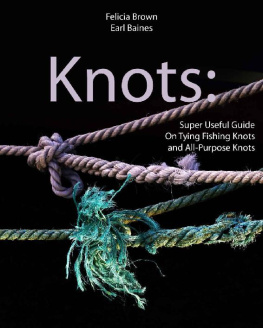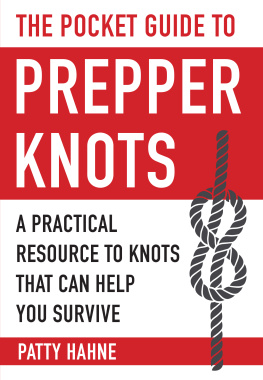Felicia Brown - Survival Hacks: Tricks Everyone Needs in The Wild + Knot Tying
Here you can read online Felicia Brown - Survival Hacks: Tricks Everyone Needs in The Wild + Knot Tying full text of the book (entire story) in english for free. Download pdf and epub, get meaning, cover and reviews about this ebook. year: 2019, genre: Children. Description of the work, (preface) as well as reviews are available. Best literature library LitArk.com created for fans of good reading and offers a wide selection of genres:
Romance novel
Science fiction
Adventure
Detective
Science
History
Home and family
Prose
Art
Politics
Computer
Non-fiction
Religion
Business
Children
Humor
Choose a favorite category and find really read worthwhile books. Enjoy immersion in the world of imagination, feel the emotions of the characters or learn something new for yourself, make an fascinating discovery.
- Book:Survival Hacks: Tricks Everyone Needs in The Wild + Knot Tying
- Author:
- Genre:
- Year:2019
- Rating:4 / 5
- Favourites:Add to favourites
- Your mark:
- 80
- 1
- 2
- 3
- 4
- 5
Survival Hacks: Tricks Everyone Needs in The Wild + Knot Tying: summary, description and annotation
We offer to read an annotation, description, summary or preface (depends on what the author of the book "Survival Hacks: Tricks Everyone Needs in The Wild + Knot Tying" wrote himself). If you haven't found the necessary information about the book — write in the comments, we will try to find it.
Felicia Brown: author's other books
Who wrote Survival Hacks: Tricks Everyone Needs in The Wild + Knot Tying? Find out the surname, the name of the author of the book and a list of all author's works by series.
Survival Hacks: Tricks Everyone Needs in The Wild + Knot Tying — read online for free the complete book (whole text) full work
Below is the text of the book, divided by pages. System saving the place of the last page read, allows you to conveniently read the book "Survival Hacks: Tricks Everyone Needs in The Wild + Knot Tying" online for free, without having to search again every time where you left off. Put a bookmark, and you can go to the page where you finished reading at any time.
Font size:
Interval:
Bookmark:
Survival Hacks:
Tricks Everyone Needs in The Wild + Knot Tying
Disclamer: All photos used in this book, including the cover photo were made available under a Attribution-NonCommercial-ShareAlike 2.0 Generic and sourced from Flickr
Table of Content:
Book 1
Book 2
Book 3

Knots
Step-by-Step Instructional Guide on Tying Knots For Any Purpose
Introduction
In our busy world, we tend to look for ways to have some kind of a hobby to release some of the stress that we are experiencing. Some of us tend to overlook this very important part because we are busy chasing our dreams and aspirations we forgot to do something to release the stress that we have accumulated from the stressful things that we are doing particularly in our respective work.
There are variety of reasons why people tend to skip hobbies such as financial, the avoidance to learn something new, and many more. When it comes to personal experience I am also like that before, I do not have any hobbies because I am lazy to learn something new. Thankfully, a friend introduced me to this hobby which is called knot tying and I never thought that I will get hooked to this kind of hobby because at first, I thought that it was really boring as you are just only sitting tying ropes.
But I was wrong because this hobby is really enjoyable as you can create different patterns of knots that will make you feel satisfied and your experience memorable. Since I learned knot tying all my stress have been reduced especially when I am doing this knot tying after work.
I learned the different techniques to improve my skills in knot tying and diligently done it every day after work which is the primary reason why I mastered it. I am much honored to share my knot tying knowledge to you through this book. This book will be composed of knot tying projects that are very friendly for beginners and you will surely enjoy doing them.
Once you mastered the projects that we will tackle you can level it up by adding some variations on it according to your own preference. At first, it is normal that you will be confused on some areas on a few topics that we are tackling, do not worry, it is normal. Just like me before when I am just starting out there are certain tying positions and methods that I did not got until I practiced it for several times and eventually mastered it.
I suggest that you do not go all the way when doing a certain project, to master the techniques what you need to do is to make it sure that you will get familiarize to a certain step first before you move on to the next step. I tell you it will be tough if you are always doing it all the way because the next time you encounter a different project that has the same steps you will have a hard time doing it.
However, if you will master every step to your heart, the next time you will encounter that kind of tying you will surely not have a hard time thus you can do it effortlessly. An advice that I can give you is you must take an interest in doing this and put the knowledge inside your heart so that you will understand the modules very well.
It does not matter if you have a background about sewing because it does not matter. You will surely learn a lot of things from this book.
Let us not delay your learning, and let us start doing the projects!
Chapter 1 What is Knot Tying?
Knots are made from the tying or fastening of ropes and cords which is commonly useful and sometimes used for decorative purposes. Knot tying is a practice of bending two rope ends or cord ends by bringing them together and performing different loops that varies on the workers desire.
The practice of knot tying takes a lot of time, but if youre willing to invest in it, you can be a professional in no time. There are different types of knots that have its own purpose, because first of all not all knots works in the same manner or application. Well be listing down these kinds of knots:
- Bend - ever wonder what are the knots used for climbing ropes. These knots are what we called bend knots, it is formed by uniting the two ends of the rope or cord of the same line. There are also different types of bend knots:
Adjustable Bend- this is the most common one, it is a kind of bend that can be easily adjusted for lengthening or shortening.
- Beer Knot- this is the specific bend applied in constructing slings used in rock climbing as it holds very tight.
- Ashleys Bend- it is a knot used in securing the ends of two ropes together. Like the other common types of knots, it also features two interlocking overhand knots.
- Butterfly Bend- it is the knot used in joining the two ends of two ropes together.
- Albrights Special- it is a bend used for angling, known for its strength, it used to join two different diameters of line.
- Blood knot- this knot is the most useful knot when youre fishing.
- Carrick Bend- this is the bend that is commonly used for very heavy ropes or cords that is too large.
- Harness Bend- it is a bend that can be pulled before securing.
Binding- it is a knot used to keep two objects together.
- Coil Knot - these are the knots used to keep ropes and cables together .
- Decorative Knot- these are the knots used in decorative purposes, theyre commonly made of repetitive patterns of knots or in different shapes.
- Hitch- a knot that is tied usually on cables and rings.
- Lashing - a type of knot that is used to hold poles.
- Loop- used to create a circle in a line .
- Plait - sometimes called braid, is made from a single simple line pattern.
- Slip- it is the loops contrast, as you pull the loop it can be closed but the slip knot cant be.
- Slipped - one great example of a slipped knot is the tying of your shoelace.
- Seizing- it is a knot used for holding two lines together.
- Sennit- unlike the plait that has only a simple pattern, this knot has a complex one.
- Splice- takes time to make but the strongest type of knot.
- Stopper - a knot you can see that holds the line inside a hole.
- Whipping- it binds the rope or cord to prevent a line from fraying.
Although some of these knots are difficult to practice, it is worth knowing that they can be useful in certain scenarios. Sometimes, these knots may save your life, especially when youre lost in the forest or other survival scenarios that you can use these knots.
Chapter 2 Knot Tying Projects For Sewing
Sewing is also common these days, but people tend to sew automatically nowadays because, for some, manual sewing can take a lot of time and effort. But enough of the automated ones, today well tackle about the different knot tying used for sewing, from common ones to the ones you probably didnt hear about.
Starting with the first project. The standard knot in sewing, it is the common way on how to hold the sewing thread into the needle. Some may find it hard doing this especially on the part of inserting the sewing thread into the needles eye but in reality, the steps are pretty easy. Here they are:
Step 1: Hold the sewing thread with your two fingers, it depends on what hand youll be using, if youre right or left handed, it is not a big deal. These steps will still apply perfectly.

Step 2: Bring the sewing thread closer to your two fingers, as having a very long allowance of the thread will make it hard for you to insert it inside the needle. After insert it inside the needle, you might want to wiggle it around so that it will fit perfectly on the hole.
Font size:
Interval:
Bookmark:
Similar books «Survival Hacks: Tricks Everyone Needs in The Wild + Knot Tying»
Look at similar books to Survival Hacks: Tricks Everyone Needs in The Wild + Knot Tying. We have selected literature similar in name and meaning in the hope of providing readers with more options to find new, interesting, not yet read works.
Discussion, reviews of the book Survival Hacks: Tricks Everyone Needs in The Wild + Knot Tying and just readers' own opinions. Leave your comments, write what you think about the work, its meaning or the main characters. Specify what exactly you liked and what you didn't like, and why you think so.









